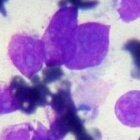Biomarkers
Biomarkers research articles, Biomarkers research article, Biomarkers journals, Biomarkers journal, Biomarkers articles, Research on Breast cancer, Biomarkers




 Latest news
Latest news
- Interview with Clinical Medicine Insights: Oncology editorial board member Prof. M. Wasif Saif
-
- 18/Jun/2010
- Interview with Biomarkers in Cancer editorial board member Dr Xiaofeng Zhou
-
- 18/Jun/2010
- Interview with Microbiology Insights editorial board member Dr Viroj Wiwanitkit
-
- 18/Jun/2010
- Interview with Cell & Tissue Transplantation & Therapy editorial board member Dr Terje Forslund
-
- 17/Jun/2010
- Interview with Nutrition and Metabolic Insights editorial board member Prof.Abdulaziz I.AL-Othaimeen
-
- 17/Jun/2010
- Interview with Biomarker Insights editorial board member Dr Steven R. Myers
-
- 16/Jun/2010
- Interview with Immunology and Immunogenetics Insights editorial board member Dr Robert Yarchoan
-
- 16/Jun/2010
- Interview with International Journal of Tryptophan Research editorial board member Dr Martin Reuter
-
- 15/Jun/2010
- Interview with Cancer Informatics editorial board member Dr Philip Crooke
-
- 15/Jun/2010
- Interview with Environmental Health Insights editorial board member Dr Lalita Bharadwaj
-
- 15/Jun/2010
- Interview with Integrative Medicine Insights editorial board member Dr Merrijoy Kelner
-
- 15/Jun/2010
- Interview with Clinical Medicine Insights: Reproductive Health editorial board member Dr Lior Lowenstein
-
- 15/Jun/2010
- Interview with Clinical Medicine Insights: Trauma and Intensive Medicine editorial board member Dr Michael Y. Wang
-
- 09/Jun/2010
- Interview with Environmental Health Insights editorial board member Dr Lars Carlsen
-
- 09/Jun/2010
- Interview with Evolutionary Bioinformatics editorial board member Dr Carsten Wiuf
-
- 04/Jun/2010
- Interview with Translational Oncongenomics Editor in Chief Dr Michael Spinella
-
- 04/Jun/2010
- Interview with Cancer Informatics editorial board member Dr Jimmy T. Efird
-
- 04/Jun/2010
- Interview with Journal of Cell Death editorial board member Dr Hardy Kornfeld
-
- 04/Jun/2010
- Interview with Journal of Cell Death editorial board member Dr Bruce S. Bochner
-
- 03/Jun/2010
- Interview with Cancer Informatics editorial board member Dr Bradley J Erickson
-
- 03/Jun/2010
- Biomarker Insights Editor in Chief co-author of Nature cover story
-
- 06/May/2010
- Author interview with Dr Esther Uña Cidón
-
- 26/Apr/2010
- Author interview with Dr Thomas Ostermann
-
- 24/Mar/2010
- Author interview with Dr Yoshihito Yokoyama
-
- 11/Mar/2010

 Latest articles
Latest articles
- Muscle Functions in Polymyalgia Rheumatica and Giant-Cell Arteritis
- Empyema Thoracis
- Increased Serum Cu/Zn SOD in Individuals with Clinical Depression Normalizes After Zinc and Anti-oxidant Therapy
- Insights into Protein Sequence and Structure-Derived Features Mediating 3D Domain Swapping Mechanism using Support Vector Machine Based Approach
- Utility of 4,5-Diphenylimidazol-2-thione in Synthesis of Fused Heterocyclic Ring Systems with Biological Interest
- Molecular Phylogeny of Edge Hill Virus Supports its Position in the Yellow Fever Virus Group and Identifies a New Genetic Variant
- Safety and Efficacy of Levonorgestrel 0.10 mg and Ethinyl Estradiol 0.02 mg Plus Ethinyl Estradiol 0.01 mg in an Extended-Cycle Oral Contraceptive Regimen
- Detection of Amide and Aromatic Proton Resonances of Human Brain Metabolites Using Localized Correlated Spectroscopy Combined with Two Different Water Suppression Schemes
- Fospropofol Disodium for Procedural Sedation: Emerging Evidence of its Value?
- Differential Human Plasma Proteomics Based on AniBal Quantification and Peptide-level Off-Gel Isoelectric Focussing
- Role of Metabolic Modulation in the Management of Chronic Ischemic Heart Disease
- Cellular Phone-Based Image Acquisition and Quantitative Ratiometric Method for Detecting Cocaine and Benzoylecgonine for Biological and Forensic Applications (Provisional PDF)
- Effectiveness and Safety of Rizatriptan Benzoate 10 mg in the Treatment of Migraine Headaches
- Editorial ISTRY Special Issue
- On the Biological Importance of the 3-hydroxyanthranilic Acid: Anthranilic Acid Ratio
- Accelerated Tryptophan Degradation Predicts Poor Survival in Trauma and Sepsis Patients
- Serum Levels of Tryptophan, 5-Hydroxytryptophan and Serotonin in Patients Affected with Different Forms of Amenorrhea
- Indoleamine 2,3-Dioxygenase in Human Hematopoietic Stem Cell Transplantation
- Proteasomal Degradation of Indoleamine 2,3-Dioxygenase in CD8+ Dendritic Cells is Mediated by Suppressor of Cytokine Signaling 3 (SOCS3)
- Effects of Acute Tryptophan Depletion on Three Different Types of Behavioral Impulsivity
Most read articles
- Current Status of Monocyte Differentiation-Inducing (MDI) Factors Derived from Human Fetal Membrane Chorion Cells Undergoing Apoptosis after Influenza Virus Infection
- Relationship Between the Plasma Concentration of C-Reactive Protein and Severity of Peripheral Arterial Disease
- Intraspecific ITS Variability in the Kingdom Fungi as Expressed in the International Sequence Databases and Its Implications for Molecular Species Identification
- Clinical Presentation and Histologic Findings at Ileocolonoscopy in Children with Autistic Spectrum Disorder and Chronic Gastrointestinal Symptoms
- A Simple Derivation of the Distribution of Pairwise Local Protein Sequence Alignment Scores
- DICOM Structured Reporting and Cancer Clinical Trials Results
- Mammoth and Elephant Phylogenetic Relationships: Mammut Americanum, the Missing Outgroup
- Evaluation of Two Outlier-Detection-Based Methods for Detecting Tissue-Selective Genes from Microarray Data
- Exploring the Evolutionary History of the Differentially Expressed Genes between Human Populations: Action of Recent Positive Selection
- Systems Biology-Based Identification of Crosstalk between E2F Transcription Factors and the Fanconi Anemia Pathway
- On the Adaptive Design Rules of Biochemical Networks in Evolution
- Phylogenetic diversity (PD) and biodiversity conservation: some bioinformatics challenges
- Identification and Quantitation of Asparagine and Citrulline Using High-Performance Liquid Chromatography (HPLC)
- Fast Genes and Slow Clades: Comparative Rates of Molecular Evolution in Mammals
- In Silico Promoter Analysis can Predict Genes of Functional Relevance in Cell Proliferation: Validation in a Colon Cancer Model
(previous 30 days)Site updates
Journal: Biomarker Insights
Journal: Bioinformatics and Biology Insights
Journal: Biomarkers in Cancer
Journal: Biomedical Engineering and Computational Biology
Feasibility of High-Throughput Genome-Wide Genotyping using DNA from Stored Buccal Cell Samples (20/May/2010)
It is unclear if buccal cell samples contain sufficient human DNA with adequately sized fragments for high throughput genetic bioassays. Yet buccal cell sample collection is an attractive alternative to gathering blood samples for genetic epidemiologists engaged in large-scale genetic biomarker studies. We assessed the genotyping efficiency (GE) and genotyping...
Validation of a Blood-Based Laboratory Test to Aid in the Confirmation of a Diagnosis of Schizophrenia (12/May/2010)
We describe the validation of a serum-based test developed by Rules-Based Medicine which can be used to help confirm the diagnosis of schizophrenia. In preliminary studies using multiplex immunoassay profiling technology, we identified a disease signature comprised of 51 analytes which could distinguish schizophrenia (n = 250) from control (n...
Elevated Serum Sorbitol and not Fructose in Type 2 Diabetic Patients (04/May/2010)
Reductions in fasting serum fructose or erythrocyte sorbitol have been proposed as markers for early proof of mechanism in clinical development of aldose reductase (AR) inhibitors. However fructose is significantly impacted by meals and evaluation of erythrocyte sorbitol poses technical challenges. To more accurately assess the performance of these markers...
The Common FTO Genetic Polymorphism rs9939609 is Associated with Increased BMI in Type 1 Diabetes but not with Diabetic Nephropathy (27/Apr/2010)
The fat mass and obesity associated (FTO) gene has an important genetic effect on body mass index (BMI) and risk of obesity, and obesity contributes to the progression of renal diseases, including diabetic nephropathy. We thus conducted a genetic association study to evaluate whether the FTO gene confers the...

Full-text PDFAbstract
Classical and Novel Prognostic Markers for Breast Cancer and their Clinical Significance (20/Apr/2010)
The use of biomarkers ensures breast cancer patients receive optimal treatment. Established biomarkers such as estrogen receptor (ER) and progesterone receptor (PR) have been playing significant roles in the selection and management of patients for endocrine therapy. HER2 is a strong predictor of response to trastuzumab. Recently, the roles of ER as a negative and HER2 as a positive indicator for chemotherapy have been established. Ki67 has traditionally been recognized as a poor prognostic factor,...
EGFR and hTERT Expression as a Diagnostic Approach for Non-small Cell Lung Cancer in High Risk Groups (08/Apr/2010)
Objective: The early detection of NSCLC is of importance because it provides chances for better outcomes. The aim of the study was to explore the clinical utility of EGFR and hTERT mRNA expression as markers for diagnosis of NSCLC. Methods: EGFR and hTERT mRNA were quantified by quantative reverse transcription...
Metastatic Colorectal Cancer: Focus on Panitumumab (30/Mar/2010)
Biologic agents designed as targeted therapy are at the forefront of research in the field of colorectal cancer. Monoclonal antibodies targeting the epidermal growth factor receptor (EGFR) represent one such form of treatment, and the novel agent panitumumab is the first fully-human monoclonal antibody developed in this class. This drug...
Cancer is a disease associated with the deregulation of multiple gene networks. Microarray data has permitted researchers to identify gene panel markers for diagnosis or prognosis of cancer but these are not sufficient to make specific mechanistic assertions about phenotype switches. We propose a strategy to identify putative mechanisms of...
Identification of Gene Networks Associated with Acute Myeloid Leukemia by Comparative Molecular Methylation and Expression Profiling (17/Mar/2010)
Around 80% of acute myeloid leukemia (AML) patients achieve a complete remission, however many will relapse and ultimately die of their disease. The association between karyotype and prognosis has been studied extensively and identified patient cohorts as having favourable [e.g. t(8; 21), inv (16)/t(16; 16), t(15; 17)], intermediate [e.g. cytogenetically...
A Novel Strategy for Mechanism Based Computational Drug Discovery (10/Mar/2010)
Glioma, the common brain tumor, which arises from the glial cells, offers worse prognosis and therapy than any other tumors. Despite the genetic and pathological diversities of malignant gliomas, common signaling pathways that drive cellular proliferation, survival, invasion and angiogenesis have been identified. Very often, various tyrosine kinase receptors are inappropriately activated in human brain tumors and contribute to tumor malignancy. During such tumourous states where multiple pathways are involved, a few of them are...
Prostate cancer is the second most common cancer and the second leading cause of cancer death in men. However, prostate cancer can be effectively treated and cured, if it is diagnosed in its early stages when the tumor is still confined to the prostate. Combined with the digital rectal examination,...
Studies investigating possible associations between cytochrome P4501B1 (CYP1B1) polymorphisms and breast cancer risk have been inconsistent. We set out to ascertain whether there might be an association between polymorphisms in exon 2 (codon 119, G→T) and exon 3 (codon 432, G→C) of CYP1B1 and breast cancer in a Chinese Han...
Identification of Gene Expression Signature in Estrogen Receptor Positive Breast Carcinoma (11/Feb/2010)
A significant group of patient with estrogen receptor (ER) α positive breast tumors fails to appreciably respond to endocrine therapy. An increased understanding of the molecular basis of estrogen-mediated signal transduction and resultant gene expression may lead to novel strategies for treating breast cancer. In this study, we sought to identify the dysregulated genes in breast tumors related to ERα status. Microarray analyses of 31 tumor samples showed 108 genes differentially expressed in ERα (+)...
Identification of Gene Expression Signature in Estrogen Receptor Positive Breast Carcinoma (11/Feb/2010)
A significant group of patient with estrogen receptor (ER) α positive breast tumors fails to appreciably respond to endocrine therapy. An increased understanding of the molecular basis of estrogen-mediated signal transduction and resultant gene expression may lead to novel strategies for treating breast cancer. In this study, we sought to identify the dysregulated genes in breast tumors related to ERα status. Microarray analyses of 31 tumor samples showed 108 genes differentially expressed in ERα (+)...
Immunohistochemistry as an Important Tool in Biomarkers Detection and Clinical Practice (09/Feb/2010)
The immunohistochemistry technique is used in the search for cell or tissue antigens that range from amino acids and proteins to infectious agents and specific cellular populations. The technique comprises two phases: (1) slides preparation and stages involved for the reaction; (2) interpretation and quantification of the obtained expression. Immunohistochemistry is an important tool for scientific research and also a complementary technique for the elucidation of differential diagnoses which are not determinable by conventional analysis...
Bimodal Gene Expression and Biomarker Discovery (04/Feb/2010)
With insights gained through molecular profiling, cancer is recognized as a heterogeneous disease with distinct subtypes and outcomes that can be predicted by a limited number of biomarkers. Statistical methods such as supervised classification and machine learning identify distinguishing features associated with disease subtype but are not necessarily clear or...
Assessment of Confounding Factors Affecting the Tumor Markers SMRP, CA125, and CYFRA21-1 in Serum (28/Jan/2010)
The purpose of this analysis was to evaluate if serum levels of potential tumor markers for the diagnosis of malignant mesothelioma and lung cancer are affected by confounding factors in a surveillance cohort of workers formerly exposed to asbestos. SMRP, CA125, and CYFRA21-1 concentrations were determined in about 1,700 serum...
This study was designed to discover blood biomarkers of cancer susceptibility using invasive multiple (n = 21), single primary breast cancer (n = 21), and control subjects (n = 20). Heparinized whole blood was incubated at 37 °C for 2 hours after 0–10 Gy of radiation, then cell cycle arrest...
A variety of post-translational protein modifications (PTMs) are known to be altered as a result of cancer development. Thus, these PTMs are potentially useful biomarkers for breast cancer. Mass spectrometry, antibody microarrays and immunohistochemistry techniques have shown promise for identifying changes in PTMs. In this review, we summarize the current...
Biomarker Validation for Aging: Lessons from mtDNA Heteroplasmy Analyses in Early Cancer Detection (27/Nov/2009)
The anticipated biological and clinical utility of biomarkers has attracted significant interest recently. Aging and early cancer detection represent areas active in the search for predictive and prognostic biomarkers. While applications differ, overlapping biological features, analytical technologies and specific biomarker analytes bear comparison. Mitochondrial DNA (mtDNA) as a biomarker in...
Decreased Serum Hepatocyte Growth Factor (HGF) in Autistic Children with Severe Gastrointestinal Disease (27/Nov/2009)
Aim: To assess serum Hepatocyte Growth Factor (HGF) levels in autistic children with severe gastrointestinal (GI) disease and to test the hypothesis that there is a relationship between GI pathology and HGF concentration. Subjects and Methods: Serum from 29 autistic children with chronic digestive disease (symptoms for a minimum of 6–12...
Since the function of the spinal cord depends on the proteins found there, better defying the normal Spinal Cord Proteome is an important and challenging task. Although brain and cerebrospinal fluid samples from patients with different central nervous system (CNS) disorders have been studied, a thorough examination of specific spinal...
Adiponectin is secreted by white adipose tissue and exists as the most abundant adipokine in the human plasma. Recent research has indicated that plasma adiponectin levels are inversely correlated with body mass index (BMI) and insulin resistance. Reduction of plasma adiponectin levels is commonly observed in the patients with type...
Changes in plasma IL-6, plasma VEGF and serum YKL-40 were determined in rheumatoid arthritis (RA) patients during treatment with etanercept alone or in combination with methotrexate. Twenty-five patients with active RA (DAS28 3.2) were randomized to receive etanercept (25 mg sc. biweekly) plus methotrexate (n = 12) or etanercept...
Biomarkers of breast cancer are necessary for prognosis and prediction to chemotherapy. Prognostic biomarkers provide information regarding outcome irrespective of therapy, while predictive biomarkers provide information regarding response to therapy. Candidate prognostic biomarkers for breast cancers are growth factor receptors, steroid receptors, Ki-67, cyclins, urokinase plasminogen activator, p53, p21, pro-...
Urinary tract infections (UTIs) are associated with significant morbidity. We rely on clinical presentation, urinalysis, and urine culture to diagnose UTI. To differentiate between lower UTI and pyelonephritis, we depend on the clinical presentation. In the extremes of age and in immunocompromised individuals, clinical presentation is often atypical posing a...
To determine if candidate cancer biomarkers have utility in a clinical setting, validation using immunohistochemical methods is typically done. Most analyses of such data have not incorporated the multivariate nature of the staining profiles. In this article, we consider modelling such data using recently developed ideas from the machine learning...
Objective: To demonstrate that the administration of an angiotensin (Ang) II type 1 receptor (AT1R) blocker (ARB) inhibits the vicious cycle of high glucose (HG)-reactive oxygen species (ROS)-angiotensinogen (AGT)-Ang II-AT1R-ROS by suppressing ROSs and inflammation, thus ameliorating diabetic nephropathy (DN). Research Design and Methods: Thirteen hypertensive DN patients were administered ARBs,...
Pathway Analysis of Differentially Expressed Genes in Patients with Acute Aortic Dissection (06/May/2009)
Background: Acute aortic dissection (AAD) is a life-threatening condition with high mortality and a relatively unclarified pathophysiological mechanism. Although differentially expressed genes in AAD have been recognized, interactions between these genes remain poorly defined. This study was conducted to gain a better understanding of the molecular mechanisms underlying AAD and...
Investigating Multi-cancer Biomarkers and Their Cross-predictability in the Expression Profiles of Multiple Cancer Types (01/May/2009)
Microarray technology has been widely applied to the analysis of many malignancies, however, integrative analyses across multiple studies are rarely investigated. In this study we performed a meta-analysis on the expression profiles of four published studies analyzing organ donor, benign tissues adjacent to tumor and tumor tissues from liver, prostate, lung and bladder samples. We identified 99 distinct multi-cancer biomarkers in the comparison of all three tissues in liver and prostate and 44 in the...











